The AMD Ryzen 3 3300X and 3100 CPU Review: A Budget Gaming Bonanza
by Dr. Ian Cutress on May 7, 2020 9:00 AM ESTCPU Performance: System Tests
Our System Test section focuses significantly on real-world testing, user experience, with a slight nod to throughput. In this section we cover application loading time, image processing, simple scientific physics, emulation, neural simulation, optimized compute, and 3D model development, with a combination of readily available and custom software. For some of these tests, the bigger suites such as PCMark do cover them (we publish those values in our office section), although multiple perspectives is always beneficial. In all our tests we will explain in-depth what is being tested, and how we are testing.
All of our benchmark results can also be found in our benchmark engine, Bench.
Application Load: GIMP 2.10.4
One of the most important aspects about user experience and workflow is how fast does a system respond. A good test of this is to see how long it takes for an application to load. Most applications these days, when on an SSD, load fairly instantly, however some office tools require asset pre-loading before being available. Most operating systems employ caching as well, so when certain software is loaded repeatedly (web browser, office tools), then can be initialized much quicker.
In our last suite, we tested how long it took to load a large PDF in Adobe Acrobat. Unfortunately this test was a nightmare to program for, and didn’t transfer over to Win10 RS3 easily. In the meantime we discovered an application that can automate this test, and we put it up against GIMP, a popular free open-source online photo editing tool, and the major alternative to Adobe Photoshop. We set it to load a large 50MB design template, and perform the load 10 times with 10 seconds in-between each. Due to caching, the first 3-5 results are often slower than the rest, and time to cache can be inconsistent, we take the average of the last five results to show CPU processing on cached loading.
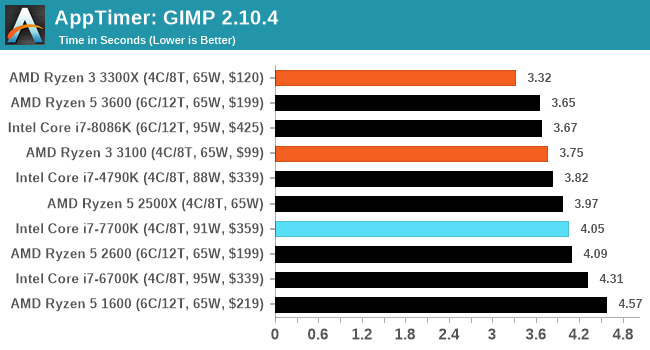
3D Particle Movement v2.1: Brownian Motion
Our 3DPM test is a custom built benchmark designed to simulate six different particle movement algorithms of points in a 3D space. The algorithms were developed as part of my PhD., and while ultimately perform best on a GPU, provide a good idea on how instruction streams are interpreted by different microarchitectures.
A key part of the algorithms is the random number generation – we use relatively fast generation which ends up implementing dependency chains in the code. The upgrade over the naïve first version of this code solved for false sharing in the caches, a major bottleneck. We are also looking at AVX2 and AVX512 versions of this benchmark for future reviews.
For this test, we run a stock particle set over the six algorithms for 20 seconds apiece, with 10 second pauses, and report the total rate of particle movement, in millions of operations (movements) per second. We have a non-AVX version and an AVX version, with the latter implementing AVX512 and AVX2 where possible.
3DPM v2.1 can be downloaded from our server: 3DPMv2.1.rar (13.0 MB)
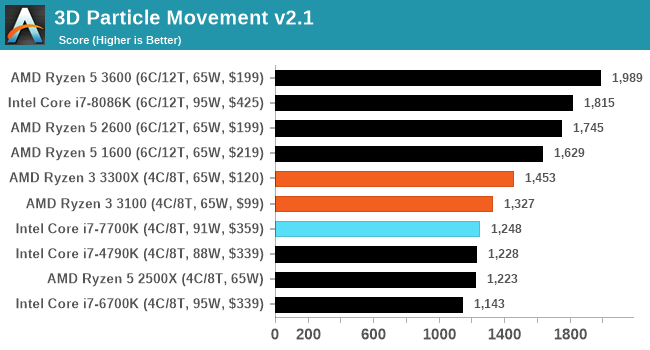
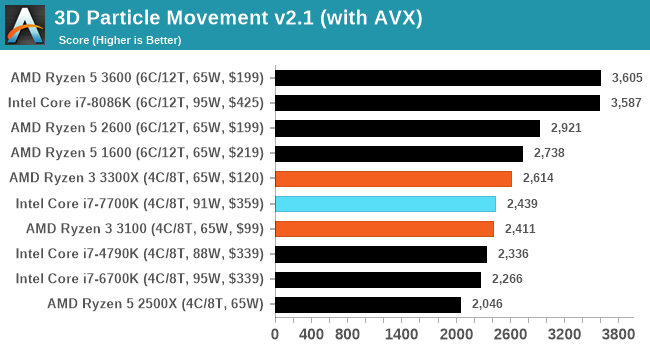
Dolphin 5.0: Console Emulation
One of the popular requested tests in our suite is to do with console emulation. Being able to pick up a game from an older system and run it as expected depends on the overhead of the emulator: it takes a significantly more powerful x86 system to be able to accurately emulate an older non-x86 console, especially if code for that console was made to abuse certain physical bugs in the hardware.
For our test, we use the popular Dolphin emulation software, and run a compute project through it to determine how close to a standard console system our processors can emulate. In this test, a Nintendo Wii would take around 1050 seconds.
The latest version of Dolphin can be downloaded from https://dolphin-emu.org/
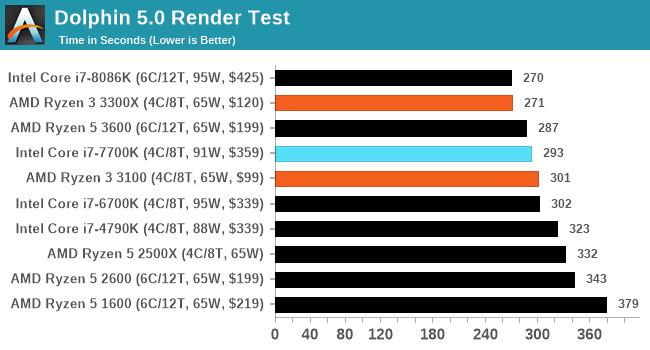
DigiCortex 1.20: Sea Slug Brain Simulation
This benchmark was originally designed for simulation and visualization of neuron and synapse activity, as is commonly found in the brain. The software comes with a variety of benchmark modes, and we take the small benchmark which runs a 32k neuron / 1.8B synapse simulation, equivalent to a Sea Slug.
Example of a 2.1B neuron simulation
We report the results as the ability to simulate the data as a fraction of real-time, so anything above a ‘one’ is suitable for real-time work. Out of the two modes, a ‘non-firing’ mode which is DRAM heavy and a ‘firing’ mode which has CPU work, we choose the latter. Despite this, the benchmark is still affected by DRAM speed a fair amount.
DigiCortex can be downloaded from http://www.digicortex.net/
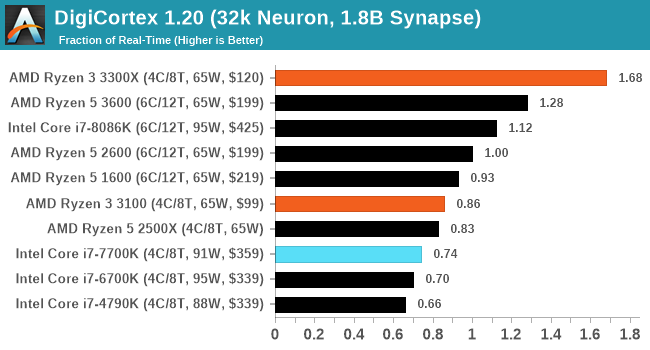
y-Cruncher v0.7.6: Microarchitecture Optimized Compute
I’ve known about y-Cruncher for a while, as a tool to help compute various mathematical constants, but it wasn’t until I began talking with its developer, Alex Yee, a researcher from NWU and now software optimization developer, that I realized that he has optimized the software like crazy to get the best performance. Naturally, any simulation that can take 20+ days can benefit from a 1% performance increase! Alex started y-cruncher as a high-school project, but it is now at a state where Alex is keeping it up to date to take advantage of the latest instruction sets before they are even made available in hardware.
For our test we run y-cruncher v0.7.6 through all the different optimized variants of the binary, single threaded and multi-threaded, including the AVX-512 optimized binaries. The test is to calculate 250m digits of Pi, and we use the single threaded and multi-threaded versions of this test.
Users can download y-cruncher from Alex’s website: http://www.numberworld.org/y-cruncher/
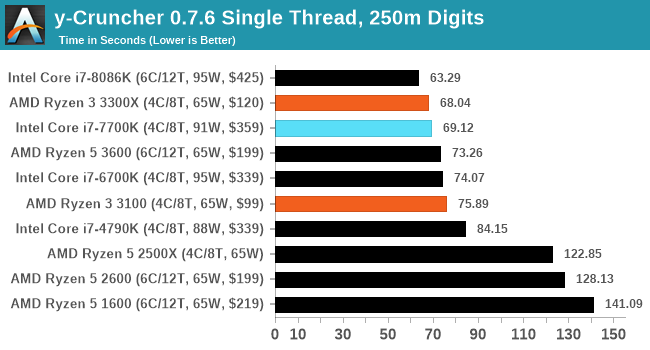
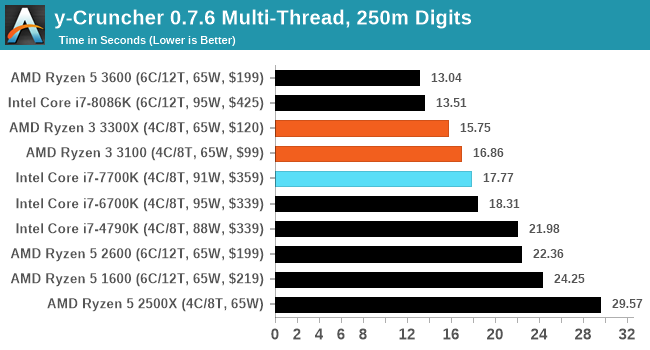
Agisoft Photoscan 1.3.3: 2D Image to 3D Model Conversion
One of the ISVs that we have worked with for a number of years is Agisoft, who develop software called PhotoScan that transforms a number of 2D images into a 3D model. This is an important tool in model development and archiving, and relies on a number of single threaded and multi-threaded algorithms to go from one side of the computation to the other.
In our test, we take v1.3.3 of the software with a good sized data set of 84 x 18 megapixel photos and push it through a reasonably fast variant of the algorithms, but is still more stringent than our 2017 test. We report the total time to complete the process.
Agisoft’s Photoscan website can be found here: http://www.agisoft.com/













249 Comments
View All Comments
Death666Angel - Sunday, May 10, 2020 - link
No. Official AMD support and motherboard manufacturer support are two different things. As stated in the article.lmcd - Sunday, May 10, 2020 - link
I misread the paragraph below it, but in general it's weird for AMD to put out a diagram quite that misleading. The ASRock AB350 was ~$120 when I bought it and is ASRock supported for the 3900X -- surely a decent percentage of boards can support most Zen 2 processors barring power constraints for the 16 core if a cheap budget build can?alufan - Monday, May 11, 2020 - link
Not true the AM$ socket will support all Ryzen chips however not all features are available on all boards such as gen 4 as this is a specific development that was not available when the 1 series launched, also the limitation is on the power system of the board not in AMDs specs"CHIPSET FEATURES: Note that not all processors are supported on every chipset, and support may require a BIOS upgrade. See your motherboard manufacturer’s website for compatibility"
I have a 3 series running in my A320 media pc in my lounge updated the bios and it works fine however i suspect if i tried a 3900 it would not have the power circuit to support it, the other issue is the bios chips in some of the older boards cannot store enough information to allow all the chips to be used, so strictly speaking the issue is with the board supplier.
trenzterra - Sunday, May 10, 2020 - link
I'm still stuck on the i5-6600K which I built back in 2016. Thought it would serve me well for many years to come given the state of Intel and AMD at that point in time, and that my previous i5-2400 lasted me a good number of years while still being competitive. Now barely four years later it's obsoleted by a 100 dollar CPU lol.lmcd - Sunday, May 10, 2020 - link
It's far from obsolete, even if it's regularly beaten. I'm still using my Sandy-E processor when I'm unopposed to simultaneously running a space heater -- it's just a question of whether you need the latest and greatest.watzupken - Sunday, May 10, 2020 - link
Actually looking that the performance of these 4 cores chip, I can't wait to see an APU with it. Even the 4 core APU will be great for every day usage, without a graphic card. I just hope they give the 4 core version a decent graphic option, rather than a Vega 6.TexasBard79 - Monday, May 11, 2020 - link
A very good review, quite in line with the others. Ryzen 3 3300X is a nasty game-changer.TheJian - Tuesday, May 12, 2020 - link
Please stop running tests that appeal to less than 5% of your audience (and I think I'm being generous here). Crysis on cpu? Who cares? What does it prove I can do today? Dwarf fortress?? WTF? Quit wasting your time and ours. AI ETH tests? What for (farms do this now)? How many tests do you need that show NOTHING to any of us?People should get the point. You are irrelevant at some point if you keep posting crap nobody cares to read. Ask toms hardware :) Oh, wait, you guys are toms. ;)
How about testing 20 games at 1080p where everyone plays. :) Is it too difficult to ask a few pros to make a script for photoshop/premier/AE to test under AMD/NV (cuda vs. OpenCL or whatever is faster on AMD)? It is almost like you guys seek benchmarks that nobody could possibly find useful IRL.
"provide a good idea on how instruction streams are interpreted by different microarchitectures."
Your PHD project tells me how these cpus will run in WHICH PRO APP? Why not just test a PRO APP IRL? Bah...fake news. Not sure why, AMD wins everything right now. Why hunt for fake tests that mean nothing? How many people use Agisoft instead of PhotoshopCC for $10 a month?
Still ripping at crap modes nobody would actually use. Again tells us nothing about what we REALLY do usually. Only a retard uses FAST settings in handbrake for anything but a 15fps training vid.
"We are currently in the middle of revisiting our CPU gaming benchmarks" and upgrading to 2080ti. Can't happen soon enough, please make sure you test games that sell over 1mil ON PC or don't bother. If the sell poorly or are poorly rated, there is no point in testing them. Test what people PLAY, at settings people really use. 720p low shows what to a person who will NEVER play below 1080p? Oh wait, I just described 99% of your audience, as I'm quite sure they haven't played 720p in ages. So much wasted testing. Stop testing 4k and test more 1080p/1440p (1440p still almost useless, wake me at 10%).
"Some of these new benchmarks provide obvious talking points, others are just a bit of fun. Most of them are so new we’ve only run them on a few processors so far. It will be interesting to hear your feedback!"
Please quit wasting your time. It feels like all your benchmarks are "for fun" as I'm not much smarter after coming here. Off to a site that tests a dozen games and some real world stuff some of us actually use (techpowerup for example...games galore, 10 REAL games tested). THIS is how you give a well rounded idea of a cpu/gpu perf. YOU TEST REAL STUFF, instead of your PHD crap or agisoft junk. People use adobe, and play games that SELL. This isn't complicated people.
Might as well jump off the roof with your cpu and tell us how fast you hit the ground. Just a useless as your benchmarks. Are they benchmarks if nobody uses them? Or is it just more "fun" crap tests that tell us nothing useful? If you are NOT helping me make a more informed decision (useful info) about buying the reviewed product, you have failed. A good review is chock full of useful info related to how we actually use the product, not a bunch of crap nobody cares about or use IRL.
https://store.steampowered.com/app/975370/Dwarf_Fo...
The devs make 3K a month from it. This is not exactly played by the world if it pulls down $35K a year. Why even bother testing this crap? Are we all going to go back to pixel crap graphics tomorrow? Heck now. Wake up. Those games (and the shite monitors we had then) are why I needed lasik...ROFL.
Spunjji - Tuesday, May 12, 2020 - link
"Only a retard uses"And that's about where I realised you weren't really making a comment so much as farting into a piece of voice recognition software.
Meteor2 - Tuesday, August 4, 2020 - link
I wonder if even one single person ever read that comment